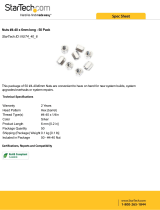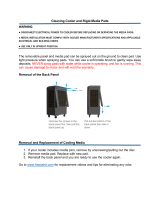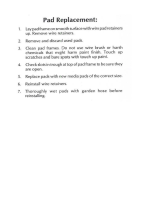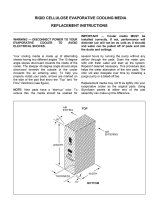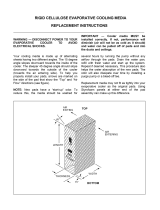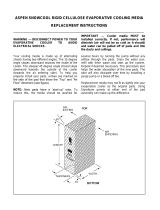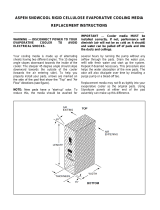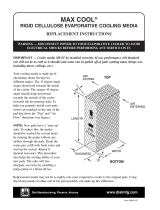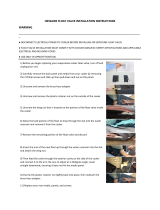Page is loading ...

Form I-REC, P/N 160201 R4, Page 1
Form I-REC (5-16)
Obsoletes Form I-REC (Version A)
Applies to: Model REC EVAPORATIVE
COOLING MODULE
INSTALLATION / OPERATION / MAINTENANCE
Model REC Evaporative Cooling Module
WARNING: Improper installation, adjustment, alteration, service, or maintenance
can cause property damage, injury, or death. Read the installation, operation,
and maintenance instructions thoroughly before installing or servicing this
equipment.
WARNING: Disconnect the power before servicing the cooling module. Failure
to do so can cause electrical shock, personal injury, or death.
A
G
E
N
C
Y
P
R
O
C
E
S
S
S
T
A
R
T
-
U
P
P
R
O
D
U
C
T
C
U
S
T
O
M
E
R
W
A
R
R
A
N
T
Y
C
O
N
V
E
R
G
E
N
T
Q
U
A
L
I
T
Y
S
Y
S
T
E
M
CQS
CQS

Form I-REC, P/N 160201R4, Page 2
1.0 General
1.1 General Information
Model REC Evaporative Cooling Module is designed as a free standing module with
duct anges for connection upstream from an air moving device. The Model REC
cooling module may be connected to an indirect-red makeup air system, a Model
ADF, ADFH, or RDF direct-red makeup air system, a blower cabinet, or to some other
type of indirect-red system or blower cabinet within the allowable CFM range. Model
REC is not recommended for connection to direct-red makeup air systems other than
Models ADF, ADFH, or RDF.
IMPORTANT: Do NOT connect a Model REC to a blow-through system.
NOTE: This product and these instructions are designed for use in an outdoor installa-
tion. The module may be adapted to an indoor makeup air application.
1.2 Warranty
For warranty information, refer to the warranty form included in the
“Owner’s Envelope”.
1.3 Installation
Preparation
Check List
Make certain the installation complies with all local, utility, and national building
and safety regulations and codes.
Check module for shipping damage. If damage is found, document the damage
with the transporting agency and immediately contact your Distributor.
Check base package against parts list below:
Description 40 50 60 70 80 90 180 360
Side Support (2)107227 (4)107227
Front & Rear Support (2)106086 (2)106087 (2)106088 (2)106089 (2)106090 (2)107235 (4)107235
Leg (2 pcs per leg) (8)107236 (16)107236
Duct Connection Angle (1)106095 (1)106096 (1)106097 (1)106098 (1)106099 (1)106100 (1)111501 (2)111501
Hardware: (10 each Sizes 40-180; 20 each Size 360) 1/4-20x3/4” Lg Cap Screw, P/N 16246, and 1/4-20 Hex Nut, P/N 10650
In addition, the following parts for making electrical and water connections may be
shipped in the bottom pan of the evaporative cooling module.
REC Size and
Type of Media
40 50 60 70 80 90 180 360*
lbs kg lbs kg lbs kg lbs kg lbs kg lbs kg lbs kg lbs kg
12” (305mm) cellulose 184 83 212 96 237 108 270 122 295 134 318 144 431 195 862 390
12” (305mm) glass ber 201 91 230 104 261 118 296 134 305 138 350 159 514 233 1028 466
* A Size 360 is two separate Size 180 evaporative cooling modules.
Qty P/N Description
1 105945
1/4" Hose I.D. x 1/2" N.P.T. Bleed Line Fitting (not used with AquaSaver timed
metering system)
2 16835 Bushings, Heyco #SR-7W-2
If optional equipment will be eld installed (Moisture Elimination Pads for Size 180
or 360 and/or a Drain and Fill or Freeze Protection Kit for any size), parts will be
shipped separately. Check to be sure that options are available for installation.
If the REC evaporative cooling module is being added to an existing makeup
air system, make certain that the system has sufcient motor capacity for the
increased static pressure. (See Appendix, page 12.)
Make certain the roof (or supporting structure) is capable of handling the additional
load of a cooling module with a full reservoir. (See weights in table.)
1.0 General ................................................................. 2
1.1 General Information ........................................2
1.2 Warranty ............................................................2
1.3 Installation Preparation Check List ................2
2.0 Dimensions .......................................................... 3
3.0 Mechanical ........................................................... 3
3.1 Assembly Instructions .....................................3
3.2 Water Flow Controls and Connections ..........5
5.0 Adjust Water Flow Over Media ........................... 8
4.0 Electrical Connections ....................................... 8
6.0 Maintenance and Service ................................... 9
6.1 Media Pads........................................................9
6.2 Water Feed Line & PVC Distribution Piping 10
6.3 Water Pump and Inlet Basket Screen ...........10
6.4 Troubleshooting Chart ..................................11
APPENDIX ................................................................ 11
Dimensions - Model REC 360 ..............................11
Cross-Reference Application Chart ....................11
Pressure Drop Table - REC Sizes 40-180 ...........12
Index ......................................................................... 12
INSTALLATION RECORD ....................................... 12
Table of Contents
Weight of Evaporative
Cooling Module with Wet
Media and Full Reservoir

Form I-REC, P/N 160201 R4, Page 3
2.0 Dimensions
Make certain the roof is level and free of debris where cooling module will be
mounted. Do not mount directly on soft tar roofs where the legs could sink and tilt
the cooler. Provide a level, weather-resistant, solid wood or metal base under the
cooling module support legs.
Make certain that there will be adequate clearance between the bottom of the
reservoir and the roof or platform to allow for drain and overow pipe connections.
FIGURE 1 - Dimensions of Model REC - inches (mm)
Size
A C D F G
inches mm inches mm inches mm inches mm inches mm
40 28-9/16 725 26-1/2 673 24 610 23-13/16 605 26-1/16 662
50 34-1/16 865 32 813 24 610 29-5/16 745 31-9/16 802
60 39-3/16 995 37-1/2 953 24 610 34-13/16 884 37-1/16 941
70 47-13/16 1214 45-3/4 1162 24 610 43-1/16 1094 45-5/16 1145
80 53-5/16 1354 51-1/4 1302 24 610 48-9/16 1233 50-13/16 1291
90 58-13/16 1494 56-3/4 1441 24 610 54-1/16 1373 56-5/16 1430
180 58-13/16 1494 56-3/4 1441 48 1219 54-1/16 1373 56-5/16 1430
Length of Transition Duct*
RDF* D
1 & 2 38” (965mm)
3 42” (1067mm)
ADF/ADFH D
300 & 500 24” (610mm)
700 & 1200 30” (762mm)
FIGURE 2 - Minimum Length of Field-Installed Transition Duct - inches (mm)
Length of Transition
Duct
REC D
40-90 24” (610mm)
180 30” (762mm)
Model REC with
Model RDF* or
ADF/ADFH
*Model RDF with over
17,300 CFM requires
REC 360; see
Appendix, page 11.
Model REC with
Indirect-Fired
Makeup Air
Systems
NOTE: See Appendix,
page 11, for cross-
reference chart.
3.0 Mechanical
3.1 Assembly Instructions
Be sure all preparations have been made. Review Preparation Check List in Paragraph
1.3. Verify that all factory and eld-supplied parts are available.
3.1.1 Base, Cooling Module, and Transition Duct
Assemble Legs - Using four bolts and nuts per leg, fasten two “halves” together. Leg
will have a top and bottom ange. Repeat for all four legs. (See FIGURE 3A.) Adjust
legs to appropriate height and tighten bolts securely.
NOTE: If installing a Size
360 which is two Size 180
modules, refer to FIGURE
17, Appendix, page 11, and
repeat assembly instructions
for both modules.
REC Size
360 is two
separate Size
180 modules -
one with right
side controls
and one
with left side
controls.

Form I-REC, P/N 160201R4, Page 4
FIGURE 3A -
Assembling Base
for Evaporative
Cooling Module
Adjustable Leg Height
16” (406mm) Maximum
9” (229mm) Minimum
FIGURE 3B - Assembled Base for Model
REC Evaporative Cooling Module
3.1.2 Installation
Instructions for
Optional Moisture
Elimination Pad,
Option ASA1 - REC
Size 180 and Size 360
If optional moisture elimination pads are included, they will be factory installed on
Sizes 40-90. On Sizes 180 and 360, the optional moisture elimination pads are
shipped separately for eld installation. Follow these installation instructions. On Size
360, procedure applies to both modules. If not eld installing this option, continue to
Paragraph 3.2.
Media pads must be removed to install the moisture elimination pads. Check the parts
with the list on the left. Follow the instructions in FIGURES 4A, 4B, and 4C to remove
the media, install the moisture elimination pads, and reassemble the unit.
Remove Media Pads (FIGURE 4A)
1) Remove the three sheetmetal screws that hold the top pad retainer.
Release the top pad retainer from the cooling module.
2) Remove the three sheetmetal screws that hold the bottom pad retainer.
Release the bottom pad retainer from the cooling module.
3) Disengage the screen retainers from the sides of the media.
Remove the inlet screen from the cooling module.
4) Slide all media pads horizontally away from cooling module until clear of bottom
reservoir pan.
Field Installed Components -
Moisture Elimination Pad
for REC 180 and 360
Qty* P/N Description
2 106049
Pad with Frame and
Screen
11 11813 Sheetmetal Screws
4 107248 Catch Pad Clamp
Add the Cooling Module - Carefully lift the pre-
assembled evaporative cooling module from both
ends and place into the center of the base assembly
being sure the airow direction is correct.
Cooling module must be level and all bolts in the
base must be secure.
Transition Duct - Connect the evaporative cooling module to the blower by means
of a eld-supplied transition duct. See FIGURE 2 for minimum length of eld-supplied
ductwork. From a top view, the transition duct must be symmetrical to the evaporative
cooling module. The evaporative cooling module is equipped with duct anges for
connection of ductwork.
Determine Base Location and Attach Rails - Position the four assembled legs in
a rectangular pattern corresponding to the size of the cooling module (FIGURE 1).
Consider minimum length of transition duct (FIGURE 2) when positioning the cooling
module base. Depending on the type of roof, it may be necessary to set the legs on a
weather-resistant, solid wood, or metal base. Module must be level.
Place rail sides on the inside of the top ange of the leg assemblies. Using the bolts
and nuts provided, bolt the side rail to the top three holes located on the legs just
below the top ange. Repeat on the remaining three legs. Tighten nuts securely.
Place the rail ends on the inside of the top ange of the leg assemblies. Bolt the end
rail to the top three holes located on the legs just below the top ange. Repeat on the
remaining three legs. Tighten nuts securely.
3.0 Mechanical
(cont’d)
3.1 Assembly
Instructions
(cont’d)
3.1.1 Base, Cooling Module, and Transition Duct (cont’d)
*Double quantities for Size
360 which is two Size 180
modules.

Form I-REC, P/N 160201 R4, Page 5
FIGURE 4A - Removing (and
Re-Installing) Media Pads
Install clamps
on one side
of cooler.
Catch Pad
Mounting Trough
Catch
Pad
Catch
Pad
Catch
Pad
Clamp
Step
3
Step
2
Step
1
FIGURE 4B - Install Moisture Elimination Catch
Pads, Option ASA1, on Sizes 180 and 360 (See
parts list, page 4.)
Install Moisture Elimination Pads (FIGURE 4B)
1) Prepare module by attaching two catch pad clamps
to one side of the cooler’s front legs. Screw through
the legs into the clamp with four of the #10 x 1/2”
long sheetmetal screws.
2) Prepare catch pads by assembling them together.
Use three of the #10 x 1/2” long sheetmetal screws.
3) Guide the catch pad assembly through the inlet
of the cooling module and place the bottom of the
lower pad into the catch pad mounting trough.
The screen part of the catch pad assembly should
always be facing the attached air mover. Slip the
catch pad assembly into the two slots located in the
catch pad clamps installed in Step (1).
4) With the pads in place, complete the assembly by
sliding one of the two remaining clamps over the
middle seam where the assembled catch pads
meet. Slip the other clamp over the top catch pad
frame and fasten both clamps to the cooling module
leg using sheetmetal screws.
After completing installation of the moisture elimination
pads as shown in FIGURE 4B, re-install the media pads
removed in FIGURE 4A. Refer to FIGURE 4C before
re-installing media pads.
IMPORTANT: Cooling media is made up of two
different sheets of cooling material. Each has its own
unique angle. When replacing the cooing media, BE
CERTAIN the 45° angle slopes downward toward
the incoming outside air. If the media is not installed
properly, water blowoff from the media pads will occur.
FIGURE 4C - Airow Direction through the
Media Pads
3.2 Water Flow
Controls and
Connections
3.2.1 Water Flow Controls
Water ow is controlled by either a oat and recirculating pump system or a timed
metering system. Follow the instructions for the type of controls on the evaporative
cooling module being installed. Float and recirculating pump type controls are
identied on the wiring diagram as Option ECD2. AquaSaver timed metering controls
are identied as Option ECD1.
Reverse Steps
in FIGURE 4A to
replace the media.
Media must be
installed with the
airow direction as
shown here.
FIGURE 5 - Re-position
the pump/junction
assembly.
For shipping, pump/
junction box assembly
is attached at the top.
Remove pump/junction
box assembly from
shipping position
(above) and re-attach
in “working” position.
To avoid shipping damage, the
pump/junction box assembly is
attached to the top of the side
panel for shipment. Support
the pump and remove the four
screws that hold the assembly
in position. Re-position the
assembly as shown in FIGURE
5, and attach using the same
screws.
3.2.2 Re-position
Pump Assembly (Opt
ECD2, oat & pump
only.)

Form I-REC, P/N 160201R4, Page 6
3.0 Mechanical
(cont’d)
3.2.3 Inlet Water and Drain Connections
Inlet Water - All Cooling Modules - Install a manual water shutoff upstream of the
inlet, at a convenient non-freezing location, to allow the water supply to be turned on
and off. If necessary, install a bleed line between the manual valve and the cooling
module inlet to allow drainage of the line between the shutoff valve and the cooling
module.
Pump and Float Controls - A oat valve (FIGURE 6) maintains the appropriate water
level in the reservoir. Use a eld-supplied 1/4” diameter tubing with a compression
nut and tubing ferrule to connect the fresh water supply to the inlet of the oat valve.
Place nut and ferrule over tubing and insert tubing into the oat valve stem. Tighten
nut securely.
FIGURE 6 -
Connect
Fresh Water
Supply to Inlet
of the Float
Valve (module
with oat and
recirculating
pump controls)
Use 1/4” tubing for
fresh water supply.
Simulates Side Panel
Float Valve Rod
Field-supplied Compression
Nut and Tubing Ferrule
Outside the Cabinet
WARNING: Water
reservoir (outdoor
systems) must
be drained and
pump motor turned
off when outside
temperature falls
below 32°F (0°C). DO
NOT operate pump
without water in the
reservoir.
FIGURE 7 -
Electrical Box
(cover removed)
and Water
Connection on
Module with
AquaSaver
Controls
1/2” Supply
Line Connection
Microprocessor
Control Location -
AquaSaver System
AquaSaver Timed Metering Control System - If the
cooling module is equipped with a microprocessor
timed metering system, connect a 1/2” water line to
the tting on the side of the cooling module
(FIGURE 7).
Due to various water pressures and installation
conditions, the water supply line may bang abruptly
when the solenoid valve in the system closes. This
banging can be minimized by installing a water
hammer arrestor in the supply line. If installing an
An optional automatic ll and drain kit (Option CT1, CT2, or CT3) will automatically release supply water to the cooling
module when a call for cooling is made and will drain all water from the reservoir when the cooling switch is deactivated
or a cooling thermostat is satised. Fill and drain kits are eld-installed. If installing an optional ll and drain kit, see
FIGURE 9, and follow the instructions that apply. Consult the wiring diagram for electrical connections.
3.2 Water Flow
Controls and
Connections
(cont’d)
Inside
Cabinet
optional water hammer arrestor, select an indoor (above 32°F/0°C) location, either horizontal or vertical, in line with
and as close to the solenoid valve as possible. Follow the manufacturer’s instructions to install and maintain the water
hammer arrestor.
A freeze protection kit is available for a module with a timed control system. It includes a two-way valve and is shipped
separately for eld installation. See FIGURE 9.
Drain and Overow Connections - All cooling modules are equipped with an overow and drain tting. The ttings are
in the cabinet bottom and come complete with a locknut and a sealing gasket. Check these ttings for tightness before
installing the overow and drain piping. The drain and overow tting will accommodate a 3/4” garden hose thread and
is tapped with a 1/2” female pipe thread for iron pipe.
Install bleed
line tting
(tting is
shipped in
the bottom
pan of the
evaporative
cooling
module).
FIGURE 8 - Bleed Line
Fitting (oat and pump
controls)
Bleed Line Connection (pump and oat controls only) – Using the 1/4” I.D.
x 1/2” N.P.T. nylon bleed line tting (shipped in evaporative cooler bottom pan;
see checklist in Paragraph 1.3), thread the tting into the female adapter on the
distribution pipe. The hose barb will protrude from the side of the cabinet (See
FIGURE 8). Attach a eld-supplied 1/4” I.D. hose to the barb and run to the nearest
drain. Discharging a quantity of water by “bleed off” will limit the concentration of
undesirable minerals in the water being circulated through the cooling module.
Minerals build up because evaporation only releases “pure water vapor” causing
the concentration of contaminants in the water to increase as the evaporation
process continues to occur. The minerals accumulate on the media, in the water
lines, on the pump, and in the reservoir.
Adequate bleed off is important to maintaining an efciently operating evaporative
cooling system.

Form I-REC, P/N 160201 R4, Page 7
Sequence of Operation for Optional Kits:
Applies to: Float and Pump System with Optional Fill and Drain Kit
(Option CT1, CT2, or CT3)
1) Call for cooling.
2) 2-way valve is energized and closes B to A.
3) 3-way valve is energized opening B to C and closing A to C.
4) During no call for cooling, valves return to normal state.
Applies to: AquaSaver Timed Water System with Optional
Freeze Protection (Option CT5)
1) Call for cooling.
2) 3-way valve is energized opening B to C and closing A to C.
3) If outside air temperature drops below freeze protection controller
setting, 3-way valve is de-energized and AquaSaver 24V solenoid valve
remains energized for eight minutes to allow complete system water
drainage.
4) During no call for cooling, 3-way valve returns to normal state.
Water Line Connections (See illustration.):
Supply (3-Way Valve) Connections - Connect the water supply line to “B”
(normally closed). Connect the water drain line to “A” (normally open). Connect
the middle outlet “C” to supply the water to the cooling module reservoir.
Drain (2-Way Valve) Connections - Connect the drain pipe from the
reservoir to “B”. Connect the outlet side to “A” and connect into drain lines
from the cooling reservoir and the supply valve.
Electrical Connections (requires black
and white 14-gauge wire) - Refer to Wiring
Diagram provided with the furnace:
WARNING: Risk of electrical shock.
Disconnect the power.
1. Refer to the wiring diagram for terminal
connections. (NOTE: If kit is not ordered with
the system, connections will not be shown on
the diagram. Terminal connections are specic
to each system. Contact the factory for
terminal connections. Be prepared to provide
all model information.)
2. Run eld-supplied black wire from the
electrical compartment (terminal on the wiring
diagram) of the evaporative cooling module
and connect to the black wire on both the
3-way and the 2-way valve.
3. Run eld-supplied white wire from the
electrical compartment (terminal on the wiring
diagram) of the evaporative cooling module
and connect to the white wire on both the
3-way and the 2-way valve.
NOTE: Follow
instructions
included in the
valve packages
for attaching
valves to the
water line only.
The remainder
of the installation
instructions with
the valves do not
apply to this type
of application.
FIGURE 9 - Water Connections including Optional Fill and
Drain Kit for a Float and Pump Control System and a Freeze
Protection Kit for an AquaSaver Timed Metering System
NOTE: If installing a Size REC360, one ll and drain or freeze protection
kit may be used for both modules if lines are manifolded.
Filling and Adjusting the Water Level in the Reservoir (module equipped with
pump and oat controls only) – Turn on the water supply. Check for a good ow.
When the oat valve (FIGURE 6) shuts off the water supply, measure the water depth.
The depth of the water should be approximately 3”. It may be necessary to adjust the
oat valve to obtain the proper water level or to free the oat valve from obstructions.
To adjust the oat valve, simply bend the oat valve rod upward to raise the water level
or downward to lower he water level.
Check for Water Leaks - All Modules - The reservoir was water tested but should be
checked again for small leaks. If any leaks are present, dry the reservoir and apply a
eld-supplied waterproof silicone sealer around corners and welds.
Proper water ow over the evaporative cooling media is critical to extend the life and
maintain the efciency of the pads.

Form I-REC, P/N 160201R4, Page 8
4.0 Electrical
Connections
All electrical wiring and connections, including electrical grounding, must be made in
accordance with the National Electric Code ANSI/NFPA No. 70 (latest edition) or, in
Canada, with the Canadian Electrical Code, Part I-CSA Standard C22.1. In addition,
compliance must be made with any local ordinances and any electric or gas company
requirements that might apply. Consult with local authorities having jurisdiction to verify
local codes and installation procedures.
The wiring diagrams in FIGURE 10 illustrate the factory-wired connections in the
cooling module junction box. Dashed lines are eld-wired.
Use the two electrical snap bushings provided to protect the tubing-encased wires
when making connections to the eld-supplied air moving equipment.
Model REC with
AquaSaver Timed
Metering Control
System, Option
ECD1
FIGURE 10 - Wiring
Diagrams for
Evaporative Cooling
Module
WARNING: Adjust ball valve only when power is disconnected
from the unit. Failure to do so can cause electrical shock, personal
injury or death.
Ball
Valve
FIGURE 11 - Disconnect
power; adjust the water
ow with the ball valve.
5.0 Adjust Water
Flow Over
Media
Model REC with
Pump and Float
Control System,
Option ECD2
CAUTION: Do not ood the media pads with extreme quantities of water for long periods as this
will cause premature breakdown of the media. An even ow from top to bottom of the media with
the least amount of water is all that is required to assure maximum efciency and media life span.
More water does NOT provide more evaporation or more cooling.
Float and Pump Control System - Using the ball valve (FIGURE 11), located in the
middle of the length of hose running from the pump to the sprinkler pipe inlet, adjust
the valve handle to allow the ow to completely dampen the media pads from top to
bottom.
Operate the unit watching the water ow. After 15 minutes with the blower in operation,
the water should have completely dampened the pads but should not be owing off the
entering side of the media. If water is owing off the entering side of the media, turn the
system off, disconnect the power, and reduce the entering water ow.
AquaSaver Timed Metering Control System - NOTE: Water ow and pad wetting
time should be adjusted at maximum airow and wet bulb depression to assure
complete wetting of the media at the extreme operating conditions.
In addition to adjusting water ow, the timing of the water on/off cycle can be adjusted.
Adjustments are correct when 1) the water rises from the holes in the sprinkler pipe
(See FIGURE 12A) consistently along the entire pipe length, 2) the media pads wet
evenly after a few “ON” cycles (no dry spots or dry streaks), and 3) a slight amount of
excess water collects at the drain at the completion of the “ON” cycle.
1) AquaSaver Water Flow Adjustment - Using the ball valve illustrated in FIGURE
12B, adjust the water ow depending on the pad height. See FIGURE 12A.

Form I-REC, P/N 160201 R4, Page 9
FIGURE 12A -
Adjust Water Flow
with the Ball Valve
in FIGURE 12B.
FIGURE 12B -
AquaSaver Water
Line showing
Solenoid Valve
and Ball Valve
Solenoid
Valve
Ball
Valve
Pad Height A = Water rise from PVC Sprinkler Pipe
24” (610mm) 1/8” to 1/2” (3 to 13mm)
48”(1219mm) 1/4” to 1/2” (6 to 13mm)
2) AquaSaver Timer Adjustment - At any given
temperature, the media pads should completely wet from
top to bottom during the ON cycle. The microprocessor
has three preset timing settings based on media size. The
appropriate setting is selected by changing the position of
the suitcase jumper at J2 on the microprocessor. Remove
the cover and check the setting (See FIGURE 13).
If the jumper is at the appropriate location for the media
(“S” for 24” or “M” for 48”), replace the cover. If the jumper
needs to be moved, move it to the appropriate setting.
The setting will go into effect when the power is restored.
Check the “ON” timing; the media pads should be wet
from top to bottom during the ON cycle.
If the preset timing is not suitable for the application, fol-
low the instructions supplied with the microprocessor to
change the calibration of the “ON” and/or “OFF” cycle.
NOTE: Prior to 2003 the AquaSaver timed cycle was controlled
by a mechanical timer. Turn the adjustment screw clockwise to
increase the ON time or counterclockwise to decrease the ON
time. One complete turn will adjust the cycle by 12-14 seconds.
FIGURE 13 -
AquaSaver
Microprocessor
Control in the
Junction Box
J2
S
M
L
12-36
(305-914mm)
Media
Height
37-48
(940-1219mm)
Media
Height
49-72
(1245-1829mm)
Media
Height
6.0 Maintenance and Service
WARNING:
Disconnect all
power to the unit
before doing any
maintenance. Failure
to do so may cause
electrical shock,
personal injury or
death.
6.1 Media Pads
Over time, excessive amounts of mineral deposits will begin to build up on the media.
Annually, scale and dirt should be washed off the entering surface of the media.
Remove the pad retainers and screen. Clean the media using a garden hose, mild
soap, and a soft bristled brush. When the media becomes too clogged with mineral
deposits and dirt that it cannot be cleaned, the pads should be replaced. The average
pad life is approximately three cooling seasons.
Select the correct replacement part numbers and order replacement media pads from
your Distributor. Follow the instructions on page 10 to remove and replace pads as
shown in FIGURE 14
REC
Media Pad
Size
Qty
Replacement P/N
12” Cellulose 12” Glass Fiber
40
24x12 2 106021 106029
24x2-3/8 1 106022 106030
50
24x12 2 106021 106029
24x7-7/8 1 106023 106031
60
24x12 3 106021 106029
24x1-3/8 1 106024 106032
70
24x12 3 106021 106029
24x9-5/8 1 106025 106033
80
24x12 4 106021 106029
24x2-7/8 1 106026 106034
90
24x12 4 106021 106029
24x8-5/8 1 106027 106035
180
48x12 4 107194 107201
48x8-5/8 1 107195 107202
360
48x12 8 107194 107201
48x8-5/8 2 107195 107202
FIGURE 14 - Removal
and Replacement of
Evaporative Cooling
Media

Form I-REC, P/N 160201R4, Page 10
IMPORTANT: Cooling media is
made up of two different sheets of
cooling material. Each has its own
unique angle. When replacing the
cooling media, BE CERTAIN the 45°
angle slopes downward toward the
incoming outside air. If the media is
not installed properly, water blowoff
from the media pads will occur.
FIGURE 15 -
Airow
Direction
through
Media Pad
6.2 Water Feed
Line and PVC
Distribution
Piping
6.3 Water Pump
and Inlet Basket
Screen (oat
and pump control
system)
Instructions for Replacing
Evaporative Cooling Media
Pads
1. Remove the three sheetmetal screws that hold the top pad retainer in
place. Release the top pad retainer from the cooling module.
2. Remove the three sheetmetal screws that hold the bottom pad retainer
in place. Release the bottom pad retainer from the cooling module.
3. Disengage the screen retainers from the sides of the media. Disengage
the inlet screen from the media pads and remove from the cooling
module.
4. Slide all media pads horizontally away from the cooling module until
clear of bottom reservoir pan. Dispose of properly.
5. Replace media by sliding media pads over both support rails until back
stop is encountered. Media MUST be placed with air ow as shown in
FIGURE 15 (left).
6. Center screen on the incoming air side of the media.
7. Replace the two side screen retainers by tting them between the side
of the media pad and the side of the cooling module. The retainers
should t snugly, pinching the screen against the media pads.
8. Replace the bottom pad retainer by securing the retainer between the
pad and the reservoir pan. Fasten with the three sheetmetal screws
removed in Step 2.
9. Replace the top pad retainer by securing the retainer between the pad
and the top of the cooling module. Fasten with the three sheetmetal
screws removed in Step 1.
Annually, the water supply line and the PVC water distribution pipe should be ushed
of debris and contaminants. Remove the media pads following the instructions above.
Remove the water feed line from the downstream side of the ball valve. On a oat and
pump system, unscrew the water bleed line barbed hose tting.
Force a fresh water supply up through the water inlet hose and thoroughly ush the
distribution pipe.
Annually, the pump and inlet screening or basket should be removed, disassembled
and cleaned.
FIGURE 16 - Remove
Junction Box, Pump
and Float Switch as an
Assembly
Pump
Motor
Pump with mesh screening over inlet
Float
Switch
Junction Box (Note: Only 208V
unit will have a transformer in
the junction box.)
6.0 Maintenance and Service (cont’d)
WARNING: Do not
expose pump motor
or any part of the
electrical box to
water. Evaporative
cooling pump is
NOT submersible.
1. Disconnect the power supply to the unit.
2. Remove the junction box door and disconnect the two power supply wires from
the terminal block inside the junction box.
3. Disconnect the water feed line hose from the upstream side of the ball valve.
4. Unscrew the four sheetmetal screws holding the junction box to the cooling
module. Remove the assembled junction box, pump, and oat switch as one
piece.
5. Either remove the screening or dislodge the inlet basket from the pump and clean
any buildup of debris and dirt. Carefully remove the base cover plate from the
bottom of the pump. Using a mild soap solution, wash all deposits from the inside
of the pump and remove all debris from the impeller.
6. Reassemble the pump. Replace the parts in exact reverse order, being careful
that everything is returned to its proper position.

Form I-REC, P/N 160201 R4, Page 11
PROBLEM PROBABLE CAUSE REMEDY
Pump doesn’t run – Unit
is calling for cooling (i.e.
console control switch is in
cool or summer position)
and reservoir is full .
1. Electrical connections (low voltage) 1. Verify all electrical connections. Verify correct voltage at pump terminals H
& J in REC junction box. See wiring diagram and Paragraph 4.0.
2. Electric oat switch. 2. Check position of the actuators on the electric oat switch.
3. Dirty pump. 3. Clean pump. See Paragraph 6.0.
4. Defective pump. 4. Replace pump.
Required water level (3”)
not being maintained
(pump & oat control
system)
1. Float valve 1. Adjust oat valve. See Paragraph 3.2.3.
2. Optional drain and ll valves 2. Check valves for proper operation. See FIGURE 9.
3. Incorrect overow pipe nipple (should
be 3-1/2”).
3. Replace pipe nipple.
4. Drain leaking. 4. Tighten drain ttings
Water running off of media
pads
1. Excessive water ow 1. Adjust ball valve in distribution line. See Paragraph 5.0.
2. Media pads need cleaned or replaced 2. Clean or replace media pads. See Paragraph 6.1.
Water not distributing
evenly
1. Distribution line clogged. 1. Flush distribution line. See Paragraph 6.2.
2. Holes in distribution line turned 2. Check position of distribution line. Holes should be spraying upward
toward diffuser. If not positioned with holes toward top, adjust position of line.
3. Pump not running on correct voltage. 3. Check voltage at pump terminal in cooling module junction box
Media pads becoming
clogged and discolored
quickly (scale and salt
deposits)
1. Bleedoff line clogged or inadequate
bleedoff (pump & oat control system)
1. Clean bleed line. See Paragraph 3.2.3. A uniform buildup of minerals on
the entering air face of the media indicates insufcient bleedoff. Increase the
rate until the mineral deposits dissipate.
2. Excessive water ow. 2. Reduce ow by adjusting ball valve in distribution line. See Paragraph 5.0.
Water blowoff from media
pads or water being pulled
from reservoir.
1. Media pads installed incorrectly. 1. Install media pads correctly. See Paragraph 6.1.
2. Requires moisture elimination pad
(over 600 FPM).
2. Install moisture elimination pad. Follow instructions, Paragraph 3.1.2.
3. Water level not 3” (pump & oat
system).
3. See second problem listed (Required water level not being maintained)
6.4 Troubleshooting
Chart
WARNING: Disconnect the power before servicing the cooling
module. Failure to do so can cause electrical shock, personal
injury, or death.
APPENDIX
FIGURE 17 - Model REC
Size 360 (two Size 180
evaporative cooling
modules) attached to a
Model RDF Direct-Fired
System
REC180
with right
side
controls
REC180
with left
side
controls
12” (305mm)
129-1/2’
(3289mm)
127-1/2”
(3239mm)
48”
(1219mm)
Field-Supplied
Transition Duct
1” (25mm) 1” (25mm)
56-3/4” (1441mm)
56-13/16”
(1443mm) - typ.
5-1/2”
(140mm)
Adjustable Legs
16” (406mm) max.
9” (229mm) min.
Control/Pump
Access Door
Water
Connection
1/4” tubing
2”(50mm) typ.
2”(50mm) typ.
2”(50mm)
6” (152mm)-typ.
6”
(152mm)
56-5/16”
(1430mm) - typ.
9-17/32” (242mm) - typ.
Drain & Overflow Connections
5” (127mm)
Drain & Overflow Connections
Supply
Wiring
Gas Supply
24V
Wiring
TOP
View
TOP
View
Model RDF Top View
REC Air Inlet View
7/8”
(22mm)
24-1/8” (613mm)
48” (1219mm)
Maximum
Length
Side View - Model RDF
with Model REC360 attached
Field -
Supplied
Transition
Duct
45-5/16”
(1151mm)
REC
Adjustable
21-9/16” (548mm) max.
14-9/16” (370mm) min.
21-1/2” (546mm)
Dimensions -
Model REC 360
Cross-Reference
Application Chart
Model Packaged Makeup Air System or Blower Cabinet REC
RGB/RPB 75, 100, 125; RDF-1-20 40
RGB/RPB 150, 175; RDF-1-40; ADF/ADFH 300; RBA Blower Cabinet 50
RGB/RPB 200, 225 60
RGB/RPB 250, 300; RDF-1-50, -1-65; ADF/ADFH 500 70
RGB/RPB 350 80
RGB/RPB 400 90
RBL Blower Cabinet; All Sizes of RGBL/RPBL/SSCBL/PGBL; All Sizes
of RDF-2; ADF/ADFH 1200; RDF-3 up to 17,730 CFM
180
RDF Models 11,000 to 28,000 CFM 360

Form I-REC, P/N 160201R4, Page 12
Appendix (cont’d)
REC CFM
Pressure Drop
REC CFM
Pressure Drop
REC CFM
Pressure Drop
REC CFM
Pressure Drop
12” Media
Moisture
Elimination
Pad*
12”
Media
Moisture
Elimination
Pad*
12”
Media
Moisture
Elimination
Pad*
12” Media
Moisture
Elimination
Pad*
40
575 0.02 N/A
60
1550 0.06 N/A
80
2750 0.1 0.06
180
3100 0.02 0.01
1000 0.06 N/A 2000 0.08 0.05 3500 0.16 0.09 4000 0.04 0.02
1500 0.12 N/A 2500 0.14 0.08 4000 0.2 0.12 5000 0.06 0.04
2000 0.2 0.11 3000 0.2 0.12 4500 0.26 0.15 6000 0.08 0.05
2500 0.32 0.17 3500 0.26 0.16 5000 0.32 0.19 7000 0.1 0.07
3000 0.44 0.25 4000 0.36 0.21 5500 0.38 0.23 8000 0.14 0.1
3500 0.6 0.34 4500 0.46 0.27 6000 0.44 0.27 9000 0.18 0.12
4000 0.8 0.44 5000 0.56 0.33 6500 0.52 0.32 10000 0.22 0.15
50
1175 0.04 N/A 5500 0.68 0.4 7000 0.62 0.37 11000 0.26 0.18
1500 0.08 N/A 5800 0.74 0.48 7500 0.7 0.42 12000 0.3 0.21
2000 0.12 0.08
70
1950 0.06 0.04 8000 0.8 0.48 13000 0.36 0.25
2500 0.2 0.12 2500 0.1 0.06
90
3100 0.1 0.05 14000 0.42 0.29
3000 0.28 0.17 3000 0.14 0.09 3500 0.12 0.07 15000 0.5 0.33
3500 0.4 0.24 3500 0.2 0.12 4000 0.16 0.1 16000 0.56 0.38
4000 0.52 0.31 4000 0.26 0.18 4500 0.2 0.12 17000 0.64 0.43
4500 0.64 0.39 4500 0.36 0.2 5000 0.24 0.15 18000 0.72 0.48
5000 0.8 0.48 5000 0.4 0.25 5500 0.3 0.18
5500 0.5 0.3 6000 0.36 0.21
6000 0.58 0.35 6500 0.42 0.25
6500 0.68 0.41 7000 0.48 0.29
7000 0.8 0.48 7500 0.56 0.33
8000 0.64 0.38
8500 0.72 0.43
8800 0.76 0.48
Pressure Drop Table - REC Sizes 40 - 180
* Moisture elimination catch pad (Option ASA1) is required above 600 FPM.
600 FPM = REC 40 w/2600 CFM; 50 w/3200 CFM; 60 w/3700; 70 w/4500 CFM;
80 w/5200 CFM; 90 w/5600 CFM; and 180 w/11200 CFM.
Installer:
Name ____________________________________________________
Company ____________________________________________________
Address ____________________________________________________
____________________________________________________
____________________________________________________
Phone _________________________________
Distributor (company from which the unit was purchased):
Company ____________________________________________________
Contact ____________________________________________________
Address ____________________________________________________
____________________________________________________
____________________________________________________
Phone _________________________________
Model __________ Serial No._____________________Date of Installation _____________
INSTALLATION
RECORD - to be
completed by the
installer:
Index
A
Adjust Water Flow Over Media 8
Airow Direction 5
AquaSaver timed metering controls 5
AquaSaver Timed Metering System 6
AquaSaver Timer Adjustment 9
AquaSaver Water Flow Adjustment 8
B
Ball Valve 8
Base 3
Bleed Line Connection 6
Bleed Line Fitting 6
C
Cross-Reference Application Chart 11
D
Dimensions 3
Dimensions - Model REC 360 11
Distributor 12
Drain 6
E
Electrical Connections 7, 8
F
Fill & Drain Kit (Opts CT1, CT2, CT3) 7
Filling and Adjusting 7
Float and Pump Control System 8
Float & recirculating pump controls 5
Float Valve 6
Freeze Protection (Option CT5) 7
G
General 2
I
Inlet Water 6
INSTALLATION RECORD 12
Installer 12
J
Junction Box 10
L
Leg Height 4
Legs 3
M
Maintenance 9
Media 9
Microprocessor Control 6, 9
Model 12
Moisture Elimination Pad 4, 5
O
Overow Connections 6
P
Preparation Check List 2
Pressure Drop Table 12
Pump and Float Controls 6
Pump & Float System, Option ECD2 8
Pump/junction box assembly 5
R
Replacing Evaporative Cooling Media
Pads 10
Re-position Pump Assembly 5
S
Serial No. 12
T
Timed Metering Control System 6, 8
Timed Metering Control System, Option
ECD1 8
Timer Adjustment 9
Transition Duct 3, 4
Troubleshooting Chart 11
V
Drain (2-Way Valve) 7
Supply (3-Way Valve) 7
W
Warranty 2
Water Connections 5
Water Feed Line 10
Water Leaks 7
Water Level 7
Water Pump 10
Weight 2
Wiring Diagrams 8
Specications & illustrations subject to change without notice and without incurring obligations.
© Nortek Global HVAC, LLC 2016. All rights reserved.
All marks are the property of their respective organizations.
O’Fallon, MO I Printed in U.S.A. (5/16)
Form I-REC (5-16), P/N 160201 R4
/
